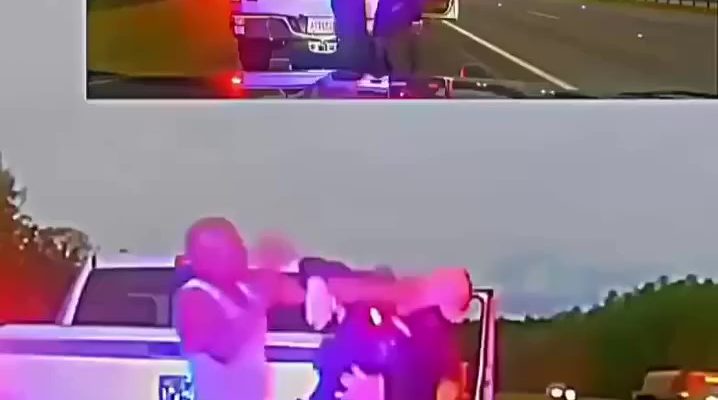Springfield, IL — What initially began as a routine police response in Springfield’s downtown area quickly escalated into a significant confrontation late Tuesday evening, leaving both a local resident and a police officer injured. The incident has drawn attention from the public, local authorities, and legal experts, reigniting conversations about law enforcement practices, community safety, and the role of transparency in policing.
How the Incident Unfolded
According to statements from the Springfield Police Department (SPD), officers were dispatched to a downtown convenience store on 5th Avenue around 9:30 p.m. following reports of a potential shoplifting incident earlier in the evening. The area is typically bustling at that hour, with shoppers, pedestrians, and nearby restaurants contributing to a busy urban scene.
Upon arrival, officers approached Michael Vance, 32, in connection with the report. Police Chief Amanda Davies explained in a press briefing that the officers’ initial goal was to question Vance and gather information regarding the alleged theft. However, what began as a standard investigative procedure reportedly escalated when Vance resisted engaging with law enforcement personnel.
Witnesses recall that the situation grew tense rapidly. “It happened so fast,” said local resident Anita Greene, who was nearby. “One moment, officers were talking to him. The next, there was a struggle, and people started shouting.”
Security camera footage from a nearby business captured parts of the altercation, showing officers attempting to restrain Vance while he resisted handcuffing. The footage, which has not yet been publicly released, reportedly shows the effort intensifying as the officers worked to maintain control.
Escalation and Attempted Arrest
Multiple eyewitnesses described a chaotic scene outside the convenience store. Passersby gathered, some filming with their phones while others retreated to maintain distance. The downtown area, typically lively with evening activity, became a scene of heightened tension and concern.
The Springfield Police Department confirmed that during the struggle, both Michael Vance and Officer Mark Jenkins sustained injuries. Additional officers arrived on the scene shortly afterward, assisting in restraining Vance and ultimately taking him into custody.
According to police statements, the injuries sustained were not life-threatening. Officer Jenkins was treated at Springfield General Hospital for facial abrasions and bruises, while Vance received medical attention for scrapes and minor contusions before being processed into the county jail.
Formal Charges and Legal Consequences
Following the altercation, prosecutors filed several charges against Michael Vance, reflecting the seriousness of the incident:
-
Resisting arrest with violence
-
Assault on a law enforcement officer
-
Petty theft, pending confirmation from the store involved
If convicted on all counts, Vance could face fines, probation, or a prison sentence spanning multiple years. Court documents indicate that his first appearance is scheduled for the coming week, where the charges will be formally addressed.
Legal experts note that cases involving assault on law enforcement officers carry additional weight, not only because of the potential for injury but also because such actions are considered offenses against public authority and the broader justice system.
Internal Affairs Investigation
The SPD confirmed that its Internal Affairs Division has opened a formal review of the incident, consistent with standard procedures whenever force is employed during arrests. The investigation will examine all relevant evidence, including body camera recordings, official police reports, security footage from surrounding businesses, and statements from witnesses.
Chief Davies emphasized the department’s commitment to transparency, stating:
“Every action taken during this incident will be thoroughly reviewed. Our goal is to ensure accountability while protecting the rights of all parties involved.”
Officer Jenkins’s body camera was active during the event, though SPD officials have not yet released the footage publicly. The department stated that it will provide the video once the preliminary review is complete, though no specific timeline has been shared.
Community Reaction and Calls for Transparency
The incident quickly became a focal point for community leaders, residents, and advocacy groups. The Springfield Justice Alliance, a local grassroots organization, urged city authorities to release unedited body camera footage promptly, highlighting the importance of public trust in maintaining strong community-police relationships.
Reactions among residents were mixed. Some expressed support for law enforcement, acknowledging the inherent risks officers face when attempting arrests in public spaces. Others emphasized the need for independent oversight to ensure that proper procedures were followed and that excessive force was not used.
James Howard, a local worker who witnessed part of the event, shared his thoughts:
“From my vantage point, it seemed the man wasn’t cooperating. But at the same time, people want to be sure the officers handled it properly. It’s a delicate balance.”
Such mixed reactions underscore the challenges police departments face in addressing public safety while maintaining community trust, particularly in urban areas with frequent pedestrian traffic.
Legal and Expert Perspectives
Legal scholars note that incidents like the Springfield altercation highlight broader debates regarding the use of force in law enforcement. Professor Linda Grayson, a criminal justice scholar at the University of Illinois, explained that courts typically assess whether officers acted proportionally to the resistance encountered.
“An assault on a law enforcement officer is taken very seriously. Courts treat it not just as a crime against one individual but as an offense against the justice system as a whole,” Grayson said.
The professor emphasized that, while resisting arrest is a criminal offense, the application of force by officers must adhere to established protocols and training standards. Investigations, such as the one initiated by Springfield Internal Affairs, are intended to ensure that all parties acted within legal and departmental guidelines.
Springfield’s Policing Context
Springfield has faced previous scrutiny regarding police use-of-force incidents, prompting ongoing dialogue around officer training, de-escalation techniques, and the implementation of body cameras. Past events have contributed to heightened public awareness and expectations for accountability.
Tuesday night’s altercation, although non-fatal, reinvigorated these discussions. Residents and advocacy organizations alike have emphasized the importance of addressing community concerns while maintaining effective law enforcement strategies.
Perspectives from Law Enforcement
Police leadership emphasized the dual priorities of public safety and officer protection. Chief Davies noted that officers often face unpredictable circumstances when responding to calls in crowded urban environments, where resistance from individuals can quickly escalate.
SPD officials stated that additional officers would be deployed in the downtown area in the days following the incident, both to ensure safety and to provide reassurance to the community.
Broader Implications for Community Relations
Incidents like this often spark questions beyond the immediate legal consequences. They raise broader concerns about trust between law enforcement agencies and the communities they serve. Balancing effective policing with transparency and accountability is critical for sustaining public confidence.
Advocacy groups argue that independent review and timely release of body camera footage are essential for preventing misunderstandings and misinformation. Public engagement, they suggest, can help address lingering questions about procedural fairness and the appropriate use of force.
Moving Forward
Michael Vance remains in custody pending arraignment, while Officer Jenkins is expected to return to duty once fully recovered. The Internal Affairs investigation is ongoing, with a focus on reviewing all evidence to determine whether departmental policies were properly followed.
Chief Davies reiterated:
“We are committed to transparency and accountability. Every step of this incident is being reviewed to ensure that the actions of our officers meet both legal standards and community expectations.”
Residents, business owners, and advocacy organizations continue to watch the situation closely, viewing the case as part of a broader conversation about the role of law enforcement in maintaining safety while respecting civil rights.
Conclusion: Lessons in Safety and Accountability
While the Springfield altercation did not result in fatalities, it serves as a case study in the complexities of urban policing. Incidents that unfold in public spaces—often witnessed by dozens of individuals—carry the dual challenge of immediate crisis management and long-term community relations.
Key takeaways from the event include:
-
The necessity of clear law enforcement protocols and adherence to training.
-
The importance of transparency, particularly through body camera use.
-
The role of community engagement in building trust and understanding.
-
Awareness that resisting arrest can have significant legal consequences for civilians.
As Springfield moves forward, this incident highlights the ongoing effort required to maintain safety, accountability, and mutual trust between police and the public. The resolution of this case will likely contribute to local discussions on improving procedures, refining training, and fostering stronger, more cooperative relationships between law enforcement and the communities they serve.



